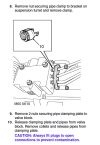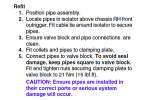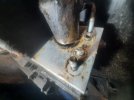SteveG4TRA
Active Member
- Posts
- 235
Last night my 2003 Discovery S2 developed a rear ACE pipe leak. Inspection this morning shows the usual pipe corrosion around the area towards the rear anti-roll system at the point it goes over the chassis outrigger clamp, forward of the offside rear wheel. It is difficult to prove it as it only leaks under pressure and up on axle stands I am not going to trigger the system on the Nanocom. But considerable seepage and staining point to this area and the pipes are very rusty. So I need to remove the two feed pies (seems sensible to do both) and fit new ones.
Now I have read various horror stories regarding this job so I have some questions:
1. Is it safe to do this job using axle stands?
2. Is it possible to release the pipe clamps on top of the out rigger, or just bite the bullet and cut them off.
3. After releasing the nuts securing the anti roll bar links to the axle does the actuator just rotate to allow access to the banjo connectors on the pipes?
4. I have heard of difficulties getting the pipe to release from the control block on the offside chassis member. Is there a secret here?
5. Where is the best place to purchase replacement pipes. They seems to be very expensive.
6. I have read that it is possible to insert a 10mm length of copper pipe using plumbers 10mm compression connectors. Any views on this as it would make the repair much less costly.
7. Am I right in assuming that following a repair that bleeding of the system can be done just by taking the vehicle in a run? This will purge any air in the system satisfactorily?
Or am I just a dreamer thinking that the ACE system will ever work again on my car!
Now I have read various horror stories regarding this job so I have some questions:
1. Is it safe to do this job using axle stands?
2. Is it possible to release the pipe clamps on top of the out rigger, or just bite the bullet and cut them off.
3. After releasing the nuts securing the anti roll bar links to the axle does the actuator just rotate to allow access to the banjo connectors on the pipes?
4. I have heard of difficulties getting the pipe to release from the control block on the offside chassis member. Is there a secret here?
5. Where is the best place to purchase replacement pipes. They seems to be very expensive.
6. I have read that it is possible to insert a 10mm length of copper pipe using plumbers 10mm compression connectors. Any views on this as it would make the repair much less costly.
7. Am I right in assuming that following a repair that bleeding of the system can be done just by taking the vehicle in a run? This will purge any air in the system satisfactorily?
Or am I just a dreamer thinking that the ACE system will ever work again on my car!





